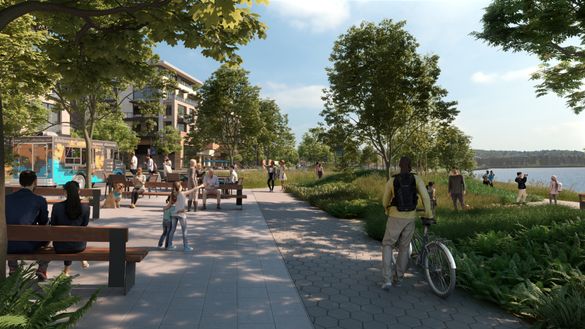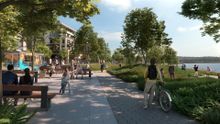 02 Feb 2021
02 Feb 2021
RiverWalk Set to Restore Access to Half-Mile of Shoreline for First Time in Over a Century
Sleepy Hollow, New York — February 1, 2021 – The Hudson is having a moment. Pedestrians and bicyclists flock to the recently opened shared-use path of the Governor Mario M. Cuomo Bridge. In nearby Sleepy Hollow, construction has commenced on the first phase of a new waterfront park at Edge-on-Hudson, designed by internationally renowned landscape architectural firm Nelson Byrd Woltz. The Sleepy Hollow RiverWalk at Edge-on-Hudson will stretch in an undulating half-mile curve along the waterfront, restoring access to a section of the Hudson that has been inaccessible for more than a century. Phase One of the new park is expected to be completed by spring of 2022, although temporary access to the waterfront has been made available immediately.
The first phase of the park, estimated to cost more than $2 million, will link trails and parkland to the south, including the Scenic Hudson RiverWalk in Tarrytown, all the way to the historic 1883 Lighthouse at Sleepy Hollow. The park will become a lynchpin connecting additional trails and parks, including the adjacent Kingsland Point Park along the Hudson River waterfront, the “Horseman's Trail” along the Pocantico River, as well as the Rockefeller State Park Preserve. The Sleepy Hollow RiverWalk will also join the Hudson River Valley Greenway, a system of designated parks, trails, kayak and canoe routes on the east and west shores of the river, from the Battery in Lower Manhattan to the state capital in Albany.
The majority of design and construction costs of the project will be borne by the developers of Edge-on-Hudson, a mixed-use, transit-oriented community rising along the waterfront in Sleepy Hollow on the site of the former General Motors Assembly Plant. Edge-on-Hudson is set to include 1,177 units of housing; a 140-room boutique hotel; 135,000 square feet of retail space and 35,000 square feet of office space, in addition to more than 16 acres of parkland. The Sleepy Hollow RiverWalk, envisioned as a new gateway to exploration of the Hudson River Valley, is also supported with a $500,000 grant from New York State's Empire State Development Market New York (ESD MNY) program.
Sleepy Hollow Mayor Ken Wray commented, “Edge-on Hudson and New York State must be commended for pursuing this superlative public space that is like no other in our region. That the construction is beginning ahead of the original schedule is a testament to the clear public benefit the Sleepy Hollow RiverWalk will provide. We look forward to inviting everyone to Sleepy Hollow to enjoy this new parkland with us.”
Edge-on-Hudson is led by master developers Biddle Real Estate Ventures (BREV) and PCD Development, LLC (PCD). The development team turned to Nelson Byrd Woltz for design of the RiverWalk, which worked in conjunction with the Village of Sleepy Hollow Open Space Council for more than 2 years. Additional planning and engineering services were provided by Divney Tung Schwalbe, with legal services from DelBello Donnellan Weingarten Wise & Wiederkehr LLP.
Nelson Byrd Woltz' design for the first phase of the Sleepy Hollow RiverWalk will feature two distinct sections of “Promenade” and “Overlook.” The Promenade features a path network, as well as a series of plazas and lawns. The Overlook offers a rise with amphitheater-style seating and expansive views of the Gov. Mario M. Cuomo Bridge and Manhattan skyline to the south, and to Hook Mountain and the scenic cliffs of the Palisades to the north.
Thomas Woltz, Principal, Nelson Byrd Woltz Landscape Architects, said, “The site's skyline views along with industrial and ecological history are the key design drivers at the Edge-on-Hudson park and the Fordham Gneiss geology beneath the surface is an inspiration for the path system. Paths interweave through berms and swales taking the visitor on a journey through rich plant palettes of native species and an artfully carved tree-shaded plaza. There are moments for respite along the path and views out over the broad sweep of the Hudson River. The prow of the site employs amphitheater-style seating to allow visitors to revel in the complexity of the southern view and the direct connection to the Manhattan skyline while the cross-river view looks to the dramatic geology of the Palisades, and the strong, wide river at their feet.”
Peter Chavkin, Founder of BREV, commented, “We're so pleased to see the remarkable level of interest in Edge-on-Hudson from across the Tri-State area. We are gratified, as well, by support from the Village of Sleepy Hollow and New York State. We believe that accelerating construction of this waterfront park ahead of the original timeline will benefit both the development and the local community.”
Jonathan Stein, Founder of PCD, added, “It's gratifying to see the vision for this project coming to life with the addition of amenities including both residential and retail components, and now the first stretch of waterfront park. Public open space, with both park and path connections, is at the heart of this development.”
More information is available at: www.edgeonhudson.com.
About Edge-on-Hudson
Edge-on-Hudson is a mixed-use, transit-oriented community set on nearly 70 acres along the Hudson River waterfront in Sleepy Hollow, NY. One of the most sought-after new developments in the Metro-New York area, Edge-on-Hudson is located just 25 miles north of Manhattan, within walking distance between two Metro-North train stations (Tarrytown and Philipse Manor), affording express access to Grand Central Terminal in just 37 minutes. New York City-based Biddle Real Estate Ventures and New Providence, New Jersey-based PCD Development are the master developers. Edge-on-Hudson is set to include 1,177 units of housing; a 140-room boutique hotel; 135,000 square feet of retail space and 35,000 square feet of office space, in addition to more than 16 acres of parkland, restoring access to the waterfront in Sleepy Hollow. More information is available at: www.edgeonhudson.com.
About Nelson Byrd Woltz Landscape Architects
Founded in 1985, Nelson Byrd Woltz Landscape Architects (NBW) is an internationally recognized design practice with offices in Charlottesville, Houston, and New York City. In the founding tradition of landscape architecture, NBW is committed to aesthetic and environmental excellence, social engagement, and innovation. Our firm has been instrumental in steering landscape architecture towards integrated, ecologically performative design, relying on science-based methodology and collaboration with a wide range of systems experts. In recent years we have been entrusted with the design of significant public parks and cultural institutions in the United States, Canada, and New Zealand, placing 30 years of design innovation in greater service to the public realm. These projects include the Public Square and Gardens at Hudson Yards in Manhattan, Memorial Park and Rothko Chapel in Houston, the Aga Khan Garden in Alberta, and Cornwall Park in Auckland.
The firm's philosophy centers on design that honors and reveals the local history and natural context of a site through a process of observation, creative interpretation, and construction to meet the goals of the client. Initial design concepts are driven by observation and analysis of the qualities that make a site unique. In the development of a design, the firm employs a vocabulary of primarily indigenous materials, including plants, paving, landforms, and multiple uses of water. We meld the particular - a place, a plant community, a certain landform - with universal archetypal qualities. This approach ensures that the local ethos of a place is never lost or homogenized while the resultant design embraces an enduring and timeless sensibility. www.nbwla.com
About Sleepy Hollow
The Village of Sleepy Hollow is located along the eastern shore of the Hudson River in Westchester County, NY. Home to approximately 10,000 residents, the Village includes a remarkable mix of historic landmarks, parkland, diverse neighborhoods and thriving businesses, including the award-winning Phelps Hospital Northwell Health. Originally settled by Algonquin speaking Native-Americans, Dutch immigrants began to arrive in the 17th century and a portion of the area became known as “Slapers Haven,” (roughly translated as “Sleepy Harbor” or later, “Sleepy Hollow”). The Village, bordered by Tarrytown to the south, was incorporated as North Tarrytown in 1874. In 1996, local residents approved a referendum changing the Village's name to Sleepy Hollow, returning the Village closer to its historic origins. The name also honored the legacy of Washington Irving's famous short story, “The Legend of Sleepy Hollow,” a fictional tale that nonetheless featured actual local landmarks that survive in the Village to this day, Including the Old Dutch Church of Sleepy Hollow, built in 1697. Today, the Village is proud to be an ethnically diverse and welcoming community. It is poised for continued growth with development of the Sleepy Hollow Common, which will offer public space and amenities in the heart of downtown, and redevelopment of the former General Motors Assembly Plant site along the Hudson River as Edge-on-Hudson, a mixed-use transit-oriented community. More information is available at www.sleepyhollowny.gov.
###



